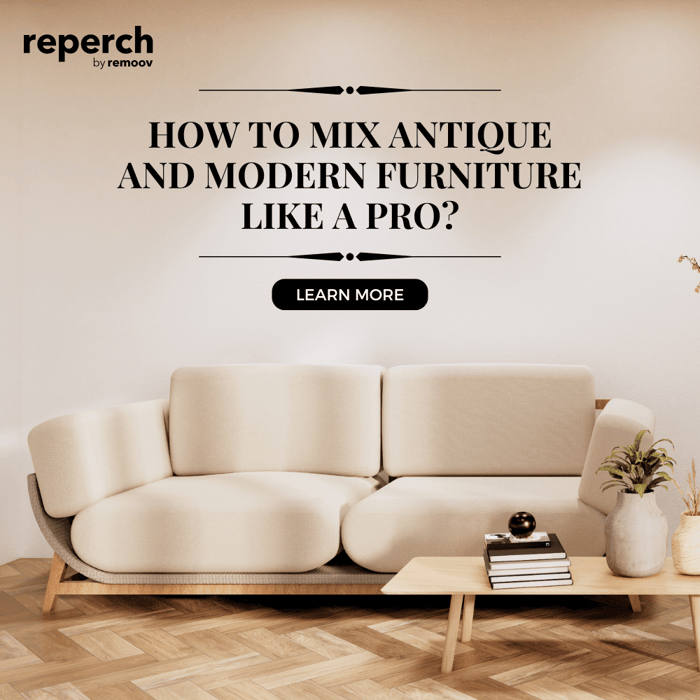Mixing antique and modern furniture is no longer just a trend. It is a hallmark of stylish, thoughtful design. When done right, the contrast between old and new creates a space full of personality, warmth, and balance. Whether you are pairing a sleek sectional with a carved wood console or placing a mid-century modern lamp on a vintage sideboard, blending these eras can lead to unexpectedly beautiful results.
In this guide, we will walk you through how to thoughtfully combine antique and modern furniture to create a home that feels cohesive, personalized, and timeless.
Why Mix Antique and Modern Furniture?
Mixing antique and modern furniture allows you to build interiors that reflect both your heritage and your taste for innovation. Here’s why this approach works so well:
1. Timeless Character
Antique furniture brings depth, story, and craftsmanship into your space. These pieces are often made by hand with materials and techniques that stand the test of time. When placed beside clean-lined modern furnishings, they become even more striking.
2. Personalized Spaces
Combining different eras creates a curated look that feels personal. You are not just picking items from one showroom. You are creating a space that tells your story.
3. Sustainable Living
Choosing antiques promotes sustainability. Instead of contributing to the cycle of mass-produced furniture, you are giving new life to quality pieces that already exist.
Start With a Statement Piece
Every room needs an anchor. Begin with one standout antique or vintage item and design around it. This could be a hand-carved armoire, a baroque mirror, or a rustic wooden dining table. The antique piece becomes a conversation starter and sets the tone for the rest of the room.
If your base is modern, a single antique piece adds contrast. If your base is more traditional, you can use modern accessories to refresh the look.
Create Contrast, Not Clutter
When mixing styles, contrast is your best friend. Pairing ornate with minimal, soft with structured, or light with dark keeps the eye interested.
For example:
A modern acrylic chair next to an antique writing desk
A clean-lined sofa with a vintage Persian rug
A traditional carved sideboard beneath a sleek contemporary mirror
The key is to avoid visual noise. Do not overload a room with too many focal points. Let each standout piece breathe.
Keep a Cohesive Color Palette
You do not need to match furniture styles, but color is one place where harmony helps. Choose a palette that complements both your antique and modern items. Neutral tones like ivory, taupe, or soft gray often work as a backdrop, allowing both styles to stand out without clashing.
Want to be bold? Pick one or two accent colors and use them consistently across both styles such as navy, emerald, or brass.
Mix Materials and Textures
Part of what makes antique and modern pairings work is how they play with textures. Juxtapose aged woods with smooth glass, or rustic metals with soft velvets.
Try these combinations:
A marble-topped antique table paired with a streamlined leather chair
A worn wooden bench beneath a modern art print
Brass lighting fixtures over a reclaimed wood console
Layering materials creates depth and avoids a flat or overly polished look.
Play With Scale and Shape
Balance heavy and light pieces to avoid a top-heavy or bottom-heavy room. Antique furniture often leans toward solid, weighty designs, while modern furniture favors sleek and low profiles.
If you are placing a large antique wardrobe in a room, balance it with a minimalist floor lamp or floating shelves. If you have a leggy modern coffee table, place it on a richly textured vintage rug to ground the space.
The contrast in scale and shape keeps the room dynamic.
Refurbish With Purpose
Antiques do not have to stay exactly as you found them. Many vintage pieces benefit from a little love. Reupholstering an old chair in a bold print or giving a wooden dresser a new coat of dark stain can breathe new life into it without erasing its character.
Not every piece needs to be preserved in a museum-quality state. Repurposing old furniture with modern touches lets you blend function with form.
Try DIY Antique Effects
If you love the look of antiques but do not have access to them, create your own. Start with modern pieces and apply dark finishes, distressing techniques, or antique-style hardware.
Some easy ways to add vintage flair to modern items:
Use dark cherry or walnut stains to mimic aged wood
Add antique-style knobs or drawer pulls
Create aging effects with layered paint or patina
Incorporate rich fabrics like brocade, velvet, or linen
These tricks help modern furniture blend effortlessly with your antique finds.
Use Accent Pieces to Bridge the Gap
Not ready to go all-in on antique furniture? Start with smaller vintage décor. Think mirrors, lamps, vases, candlesticks, or side tables. These can add depth to a modern room without overwhelming it.
For example:
A vintage curio lamp next to a modern sectional
An antique trunk used as a coffee table
Indian wooden wall panels used as art in a sleek hallway
These accent pieces serve as gentle introductions to antique design.
Use Lighting to Tie It All Together
Lighting is often the unsung hero of design. It not only brightens a space but can also help connect contrasting furniture styles.
Try hanging a vintage chandelier over a contemporary dining table, or use modern pendant lights in a room filled with traditional furniture. Brass, bronze, or wrought-iron fixtures often blend well with both styles.
Use lighting to highlight key design elements and draw attention to your favorite mix-and-match moments.
Focus on Function, Not Just Form
Your space should feel livable, not like a showroom. When combining antique and modern furniture, prioritize pieces that serve a purpose. A vintage dresser that also offers storage. A modern armchair that is actually comfortable.
Do not let aesthetics override practicality. Your home should support your lifestyle.
Real-Life Combinations That Work
Living Room:
Place a minimalist sofa opposite a vintage wooden coffee table. Add throw pillows in antique-style fabrics and finish with a modern floor lamp.
Dining Room:
Pair a farmhouse-style dining table with modern wire chairs. Top it with an antique brass candelabra.
Bedroom:
Anchor the room with a sleek upholstered bed and complement it with vintage bedside tables and a traditional area rug.
Entryway:
Use a carved antique console table under a simple round mirror. Add a tray for keys and a sleek wall sconce above.
Final Tips
Start small if you are nervous. Add antique accents and slowly build your confidence.
Keep your eyes open at estate sales, flea markets, and trusted resale platforms like Reperch.
Remember that great design is not about matching. It is about telling a story with pieces you love.
Why Reperch?
At Reperch, we believe every piece of furniture has a story. Our curated secondhand marketplace is designed to help you discover one-of-a-kind finds that elevate your home, support sustainability, and make a visual impact.
Whether you are searching for antique treasures or contemporary favorites, we have made it easier than ever to mix styles confidently. Explore our collection today and find the perfect balance of past and present.








